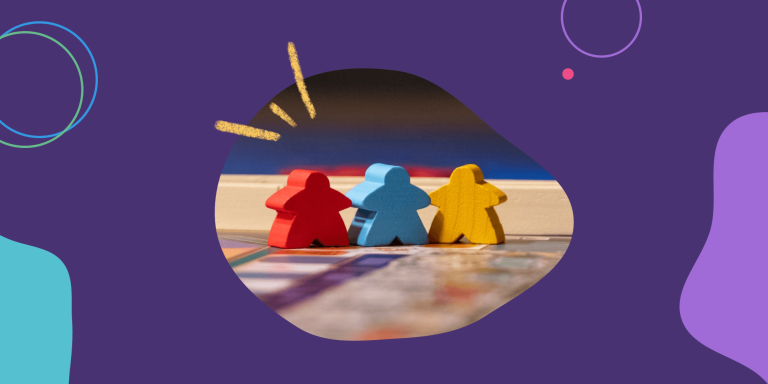9 Participant Pro-Tips for Fun & Effective Sprint Retrospectives

During a retrospective, facilitator leads 6 to 13 participants through a structured process to reflect on their shared work, find patterns, and decide how to respond to those patterns.
While the facilitator has an outsized role in creating a good retrospective, most folks in the retro aren’t facilitators – most are participants, and they have an important role to play too.
Just as facilitators embrace certain practices to lead better sprint retros, participants can create a better experience for themselves, support their team and get more out of retrospectives by embracing certain practices too.
Let’s look at what a participant actually does in a retrospective, and then talk about how you can improve the way you reflect, group, vote, discuss and wrap up as a participant so you can enjoy more fun and effective retrospectives.
What is the role of a participant in a Sprint Retrospective?
While the facilitator role is well-discussed, what participants bring to the table is less obvious.
On a practical level, participants will:
- Add reflections in response to prompts selected by the facilitator: That means writing on sticky notes or virtual cards to share their perspective on how the sprint went.
- Group cards and vote on topic areas: This could mean moving reflections around collaboratively, or agreeing with the facilitator as they define groups. For voting, you’ll likely be given a number of votes to place on groups you find most important.
- Suggest, commit and act on next steps: Once you’ve found patterns and voted on their importance, you’ll talk with your teammates about what you want to do, and will probably be responsible for some set of actions during the following sprint.
In all of these phases, the most important role of each individual participant is contributing their unique perspective to the conversation. Every person on the team ‘sits’ – perhaps literally but also figuratively – in a different place, and so everyone sees different things. For example, you may be the only one who was online when a critical bug came in, so you uniquely understand how it escalated.
During the retrospective meeting, you might be the only one that’s quiet while others are vigorously debating something, which means you have the unique perspective of what the discussion looks like from the outside, and can lend that context to the discussion.
Whatever your role and point of view, you’re the only one that can add it to the rich mix you’re creating as a team. That’s the biggest value that you can add.

But if you’re already doing that, there’s another role to consider: participants can actively support the facilitator and team in moving the retrospective forward.
Facilitators have a lot to track during a retro – how much time you have, who has and hasn’t talked, what issues have and haven’t been brought in, and so on.
As a participant, especially if you’ve been with the team for a while or don’t have much to share about a particular sprint, you might have extra capacity during the retrospective. You can help everyone out by noting when you’re short on time, asking others for their perspective if they haven’t shared it, or just moving cards around during the grouping phase. What’s appropriate will, of course, depend on the exact culture of your team.
With that in mind, let’s talk through how you can bring your perspective and assist the facilitator throughout an agile retro.
1. Reflect on your own to prepare for the Sprint Retrospective
A lot can happen during a two week sprint, and if your sprint cadence is longer, that’s even more work and time to try to recall on the spot.
Get yourself in the right mindset by taking some time to think about what happened before you start writing reflections.
That could mean:
- Look at your notes from the previous retrospective to remind yourself about what you said you’d do, and think about whether it happened
- Browse through anywhere else you shared work, like videos or comments in chat tools
All of this will ground your thinking and help you write more complete reflections.
You might also consider building a personal reflection practice, like taking some time each week to jot down some notes or journal about how the week went.
Those notes will be a rich source to pull reflections from.
2. Focus reflections on the team rather than tasks
Once you have a sense of what went on, it’s time to consider what you want to share about it.
While specific tasks will change from sprint to sprint, processes and team dynamics will last until you do something to change them. Those processes and dynamics will feed everything you do, where a particular issue or project is more like a one-off.
If you can find patterns in the team and process, and then act to improve them, you’ll be on your way to improving how you work in general, and not just on a particular task.

When writing reflections, try to avoid something like “This task went well,” and instead dive into what made that task go well – the dynamic underneath. That might sound like, “I got quick, detailed feedback from multiple people on this PR, so I had a better sense of what to change.”
3. Make reflections specific and anecdotal
While long reflections can be hard to write, very short reflections don’t really tell your colleagues much about what happened. Oftentimes, the devil is in the details – just knowing something went well or poorly doesn’t give you enough information to decide what to do about it.
When writing reflections, be as specific and anecdotal as possible – write a one to two phrase story about what happened.

If you’re not sure how to write this, try one of these reflections starters:
When [thing that happened], I felt [your experience]. That led to [outcome].
Ex: When the site went down, I felt unsure about how to triage. That led to a slower response time.
[Event] went [well/poorly/etc] because [Reason].
Ex: Shipping to production went more smoothly than last week because every PR had been reviewed thoroughly before merging.
[Process] is [helping/hurting/etc] our [Goal]. Instead, [Outcome] is happening.
Ex: Requiring multiple PR reviewers is hurting our velocity. Instead, we’re shipping slowly because PRs sit around for extra reviews.
By writing more of a narrative to explain what went on, you contribute more of what you saw. You’re sharing not just that something went well, but your personal experience of why. As a reminder, sharing more of your experience is your most important role as a participant!
But more than that, you’re also giving the team the opportunity to unpack what happened. Saying something happened doesn’t give you much to dig into. Saying why it happened and what details you noticed gives your team more to talk about.
4. Group reflections to assist the facilitator
In the grouping phase, someone will read reflections out loud and then will place reflections near others that seem related.
How the grouping phase works exactly will depend a lot on whether your retrospective is co-located or remote, and the exact culture of your team. But in any case, the grouping phase can be logistically tricky for the facilitator because not only do they have to group reflections without them overlapping too much (or falling off the whiteboard!), but they have to do it while reading reflections, identifying patterns among them, and communicating how they’re grouping. It’s a lot to keep track of.
Participants can help the facilitator by:
- Reading the reflections out loud and letting others or the facilitator group them
- Taking the responsibility of moving the cards around, so the facilitator can focus on reading the cards
By taking an active role in the grouping phase, you’ll have some subtle influence on the topics you discuss because you’re the one spotting themes and managing the groups.
Splitting up grouping into different roles like this also means more of the team is engaged in the process. If you want to make sure you all stay on equal footing and everyone stays engaged in the meeting, you could suggest rotating different roles within the grouping phase, like reader and organizer.
5. Experiment with different voting strategies to shake up the conversation
In the voting phase, each participant gets a certain number of votes to place on the different groups. It’s a quick way to gauge the relative importance of these topics for the team.
While the facilitator decides how many votes everyone gets and how many they can put on any one topic, as a participant, you can work within the system to create different outcomes.
Let’s say you’ve been given six votes to dole out, you could:
- Put it all on one: This is a strong signal that you think one topic is really important. Especially in smaller groups, it’s a powerful way to force discussion on something that really matters to you.
- Put one on each group you’re interested in: This spreads out your influence across many topics. If you’re not feeling very strongly about any one topic, this is a more passive approach.
- Try the 3-2-1 strategy: This best-of-both-worlds strategy lets you put a strong signal on one group, but also spread your influence around a bit. It gives you breadth and depth.

All of these strategies influence the conversation in different ways. If you’ve been on a team for a while and notice one particular topic continues to be ignored, then the all-on-one strategy might tip the scales and get a productive conversation going. If you’re feeling lukewarm on all the topics, then the equal voting strategy may be the way to go.
Whichever strategy you pick, consider what conversation you want the group to have. This is another opportunity to share your specific point of view by influencing what the team talks about.
6. Add value by taking notes during the discussion phase of your retro
After the structured Reflect, Group and Vote phases, you’ll move into a more open ended phase: Discussion.
This phase is often pretty free-flowing. While the intention is to come up with some action items, there’s no prescribed way to get there. That means it’s easier to lose the thread or meander off the path during this phase.
It’s the facilitator’s job to keep things on track, but as a participant, you can help by taking notes on the conversation.
Writing down what’s being said will help in two ways:
- You’ll record the discussion for the future –Where spoken words are ephemeral, the notes you’re taking can live on and be a helpful reminder if you come upon a similar issue in the future
- You’ll make the invisible thread visible – When teammates literally see the conversation, they may feel understood (and not need to reiterate their points as much) or might notice a connection or solution that didn’t click from just the verbal input.
In Parabol, this can even become a multi-player activity, as team members add comments and reactions to the discussion thread.
7. Before committing to an action item, ask if you could make it smaller
When you’re discussing what to do, it’s easy to get into a ‘lets change it all’ mentality. With everything out on the table, there’s a desire to do something big now that you can see what’s going on.
But doing something big is…well… hard.
Big shifts are hard to get everyone to agree to, and usually difficult to enact.
Instead of a big change, try thinking about the smallest step you could take towards resolving or addressing a pattern you’ve spotted.
Ask yourself and your team, ‘how small can you make it?’
Small improvements, executed quickly and at a rapid cadence, will yield faster changers than big improvements executed slowly, one after another, over a long period.
As a participant, if you see a tendency towards trying to find a big thing, prompt the team to think of the smallest first step. Committing to doing something achievable will feel great.
8. Share when you’re ready to move on to keep the conversation flowing
We’ve all been in that retrospective where you get to a topic, and there are two people who care a lot about it, and won’t let it go.
The rest of the team sits silently, hoping (perhaps even praying) they’ll finish soon. Ideally, the facilitator should close out the discussion and move to the next topic, but they’re one of the folks talking.
As a participant, you can help move the conversation forward by sharing when you’re ready to move on.
How you do that will depend on what tool you’re using. In Parabol, there’s an ‘I’m ready’ button for this. In Zoom, Google Meet or Microsoft Teams, you can use the ‘raise hand’ feature to give a signal that you’re ready. In all these tools, you can also try sharing something in the chat to signal you’re ready to move on.
Now, if you’re in person, this could get tricky. Unless you have some predefined rules for handling such a situation, you’ll need to interrupt the conversation, which might feel a bit aggressive.
Try something like:
Excuse me – Jake, Paul, it seems like you’re really concerned about how we address this topic, but I’m aware of our time constraints for this meeting. Could you maybe talk about that separately?
For teams that struggle with moving along or run into this issue frequently, you might consider setting a timer for each discussion item. We recommend seven to 10 minutes. The facilitator can use a timer as a reminder, and as participant, you can nudge them as well if the time has elapsed. You can even volunteer to keep the time, to take something off their plate.
9. Ask for your next sprint retrospective meeting
Many agile teams have regular retrospectives, scheduled as a recurring meeting on everyone’s calendar.
But sometimes these fall through the cracks:
- If you’ve had a few lackluster retros, it’s easy to stop having them
- If you’re just getting into an agile rhythm, you may not have committed to recurring meetings yet
- If you’re busy, you might think cutting out retros is a way to save time
- If you’re not practicing agile, you might think you can just schedule your next retro ‘when you need to’
Don’t fall into this trap.
Retrospectives are a practice, like running or yoga. An individual session may not feel transformative, but after you’ve done them consistently over a bit of time, you’ll be amazed at how you’ve changed.
You wouldn’t schedule a single training session before a marathon, don’t think you can build continuous improvement with a single retrospective meeting.
To put your team on the right path, ask to get your next retrospective on the books as soon as you finish your current one. If you’re not ready to commit to a recurring invite, just ask for the next retrospective – commit to holding just one more.
This could sound something like:
I really enjoyed that conversation! Can we schedule the next one?
I’d like to make sure I have time to reflect before we do our next retro. Can we go ahead and get it on the books?
I know things can get crunched towards the ends of projects – can we schedule our next retro now, so we don’t have to worry about it later?

Once you reserve the time, you’ll plan around your retrospective, rather than trying to squeeze a retro into an already cramped schedule. Having the time booked makes you much more likely to do it again.
Engaged participants create fun and effective retrospectives
It might take two to tango, but it typically takes a few more to make a great retrospective.
While facilitators have an important role in setting the stage for a successful retro, most people in the real-or-metaphorical room are participants, and how they play their part has a substantial impact on whether the time they spend together was worth it.
If you’re ready to be a better participant, we shared nine pro-tips for you to try.









